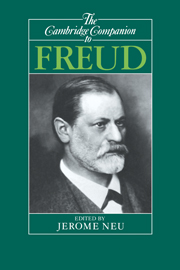Book contents
- Frontmatter
- Introduction
- 1 Freud: The psychoarcheology of civilizations
- 2 Seduced and abandoned: The rise and fall of Freud's seduction theory
- 3 Freud's androids
- 4 The interpretation of dreams
- 5 The unconscious
- 6 The development and vicissitudes of Freud's ideas on the Oedipus complex
- 7 Freud and perversion
- 8 Morality and the internalized other
- 9 Freud on women
- 10 Freud and the understanding of art
- 11 Freud's anthropology A reading of the “cultural books”
- 12 Freud's later theory of civilization
- 13 In fairness to Freud: A critical notice of The Foundations of Psychoanalysis, by Adolf Grünbaum
- Bibliography
- Cited works of Freud
- Index
- Series list
2 - Seduced and abandoned: The rise and fall of Freud's seduction theory
Published online by Cambridge University Press: 28 May 2006
- Frontmatter
- Introduction
- 1 Freud: The psychoarcheology of civilizations
- 2 Seduced and abandoned: The rise and fall of Freud's seduction theory
- 3 Freud's androids
- 4 The interpretation of dreams
- 5 The unconscious
- 6 The development and vicissitudes of Freud's ideas on the Oedipus complex
- 7 Freud and perversion
- 8 Morality and the internalized other
- 9 Freud on women
- 10 Freud and the understanding of art
- 11 Freud's anthropology A reading of the “cultural books”
- 12 Freud's later theory of civilization
- 13 In fairness to Freud: A critical notice of The Foundations of Psychoanalysis, by Adolf Grünbaum
- Bibliography
- Cited works of Freud
- Index
- Series list
Summary
For many years, Freud's “seduction theory” of neurosis was seen as an erroneous if initially plausible step on his way to the mature theory of psychoanalysis, and his account of his rejection of the seduction theory was taken essentially at face value. More recently, with the increasing appreciation of child sexual abuse, classical psychoanalysis has been criticized for dismissing childhood reality as infantile fantasy, interest in the seduction theory has been revived, and Freud's motives for abandoning it have been sharply questioned. The story of the rise and fall of the seduction theory thus takes on new interest and significance. Perhaps its most crucial lesson is the importance of theory in psychoanalysis. Theoretical presuppositions played a major role in creating the theory, in causing Freud to abandon it, and in helping him produce a replacement. Theoretical considerations also explain why, though Freud never ceased believing in the reality of sexual abuse in childhood, he could not find a causal role for it once he had adopted his new theory.
The climax of the story is well known. In his letter of September 21, 1897, Freud announced to Wilhelm Fliess, "I no longer believe in my neuiotica" (1985 [1887-1904], 264), the seduction theory he had tenaciously defended for the two preceding years. His reaction to this event seemed paradoxical even to him. It was, he wrote, "the collapse of everything valuable" in his recent theoretical efforts, yet he had "more the feeling of a victory than a defeat (which is surely not right)." But it was. The famous letter was as much birth announcement as obituary. Less than two months later, Freud sent Fliess with mock fanfare the first outline of his theory of infantile sexuality and its role in the formation of neurotic symptoms in adulthood.
- Type
- Chapter
- Information
- The Cambridge Companion to Freud , pp. 25 - 43Publisher: Cambridge University PressPrint publication year: 1991
- 5
- Cited by

